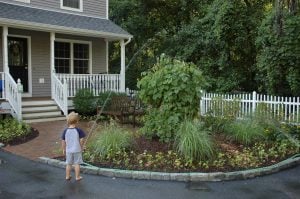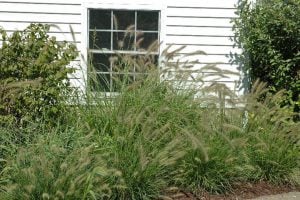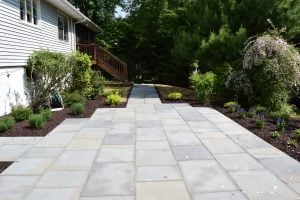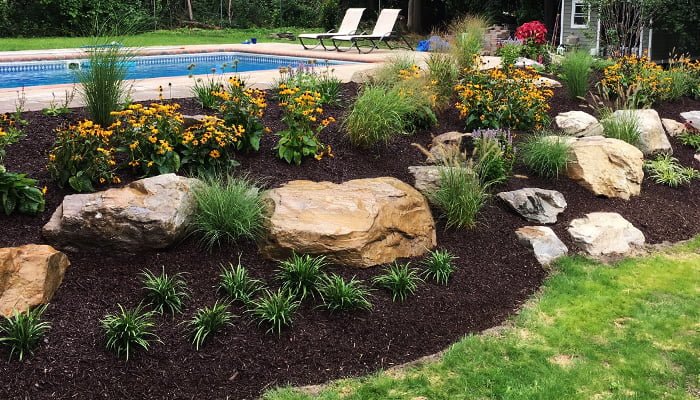Often times, homeowners think that landscaping is one of the simplest home projects and it doesn’t require much planning, research, or thought – but actually it does. If the planning and research phase of your landscaping project is neglected, this can actually cause some unforeseen issues. Here are 10 of the most common landscaping mistakes that could easily be avoided.
- No Plan – It’s easy to misunderstand the complexity of landscape jobs, especially with remodeling shows like those on channels like HGTV that portray these updates as quick and simple. But really, they take planning and research. Not only do you want your landscape to be visually appealing, and balanced, but there are also a lot of important things to consider beyond this; plants best for seasonality of your location, native plants, plants that work well together, expected size of matured tree or plant, proximity to house, hardscaping and architectural features, functionality, etc.
- Haphazard Placement – If you do not plan for your landscaping project, or you plan improperly, you may end up with an unbalanced landscape with placement that looks haphazard. Balance is one of the main design elements when planning a landscape design project. Balance is not to be confused with symmetry. Symmetry is great in a landscape if that is what you’re going for. But, asymmetrical designs also work great if they are done well and purposefully. Even in an asymmetrical design, cohesiveness is important to help avoid the haphazard look. An easy way to end up with a haphazard look, unintentionally, is by not planning your entire design before beginning. You figure you’ll do one section and then keep adding to it until it is complete, right? This can cause unexpected problems and a poorly designed finished project.
 Overlooking Maintenance – Your landscape and garden is an investment, and like every other aspect of your home, it requires maintenance. While some backyard features are more low maintenance than others, none require no maintenance. Consider maintenance when planning for your project. If you do not maintain your landscaping, then all of your planning and finances that went into the project will go to waste.
Overlooking Maintenance – Your landscape and garden is an investment, and like every other aspect of your home, it requires maintenance. While some backyard features are more low maintenance than others, none require no maintenance. Consider maintenance when planning for your project. If you do not maintain your landscaping, then all of your planning and finances that went into the project will go to waste.- Ignoring Functionality – It is easy to get so excited about your landscape vision that you forget to consider functionality. This could be a big landscaping mistake that could result in having to redo your project, or get rid of some features after completion. Consider what you will be using your space for. If you are a big entertainer, you want to make sure you are incorporating functionality features to make entertaining easier; seating, a patio, consider a fire pit, a grilling station, etc. If you have small children, you definitely want to consider safety. A large water feature or pond may not be the safest for this situation. Also, an area with a lot of small pebbles may be something you desire, but could this be a choking hazard for your young children that are playing around in the yard?
- Forgetting About Seasons – If you live in an area with 4 seasons (like NY), it is important to consider all of the seasons when you are planning. If you are only planning for spring bloom then your yard can look unsightly and drab in winter. While your yard will never look its best during dormant seasons, there are some landscape design elements that are designed for that winter pop! Also, if there are plants that need warm weather all year round to survive and thrive, you may not want to incorporate these into your plan.
 Forgetting the view from inside – Forgetting to think about how your landscape will look from the inside of your house is a very common landscaping mistake. If you still want to be able to receive natural sunlight into your home, or be able to see out of your window, consider the size of the landscape you are planning in this area. You also don’t want the backside of your landscape to be unsightly from the inside.
Forgetting the view from inside – Forgetting to think about how your landscape will look from the inside of your house is a very common landscaping mistake. If you still want to be able to receive natural sunlight into your home, or be able to see out of your window, consider the size of the landscape you are planning in this area. You also don’t want the backside of your landscape to be unsightly from the inside.- Too many colors – As much as colors can bring brightness and beauty to your yard, too much of anything can have the opposite effect. A good way to organize your color palettes is to designate a general color scheme for each section, rather than putting all of the colors together.
- Improper placement – Choosing the right plants for the right area of your yard is a part of the planning stage. Planting trees and plants in the wrong places can eventually lead to the dying of all. Consider how much sun a plant needs, how large it will grow, how close to plant them to each other, how close to your home to plant them etc. If plants are planted too close to each other, there may not be enough nutrients for them all. Additionally, if a type of plant or tree needs an abundance of sun, make sure it is planted in an area that is very rarely shaded.
- Not Enough Foliage – Planting foliage in addition to flowering plants and fruit trees can help to achieve that year-round clean look, as flowers and fruits only bloom for part of the year.
 Using Only Plants – A huge aspect of landscape design is the “non-plant” features; hardscaping, stones, benches, water features, etc. These accent items can really help to make your landscape stand out, and increase your home’s curb appeal. However, it is important to understand that these are accent elements and not to overdo it.
Using Only Plants – A huge aspect of landscape design is the “non-plant” features; hardscaping, stones, benches, water features, etc. These accent items can really help to make your landscape stand out, and increase your home’s curb appeal. However, it is important to understand that these are accent elements and not to overdo it.
Having a detailed landscape plan is essentially the way to avoid all of these common landscaping mistakes. Remember to plan for all of these elements during the design stage. Red Cedar Landscapers can provide you with a detailed plan, drawing, design, and maintenance plan specific to your yard and your style preferences. Contact us today for your free consultation, and let us help turn your landscape visions into a reality; without any of these common landscaping mistakes!


